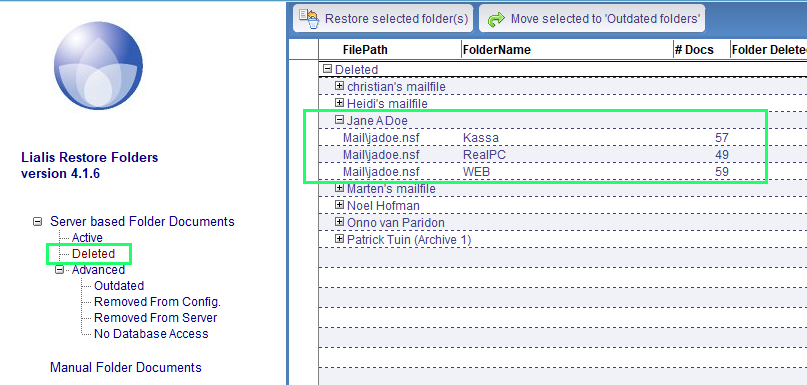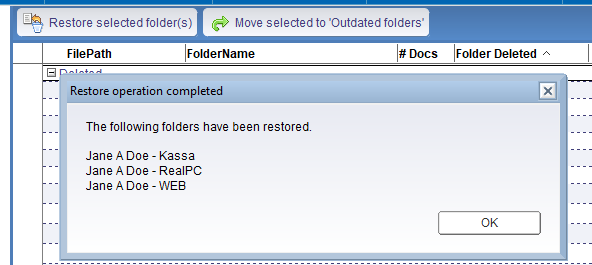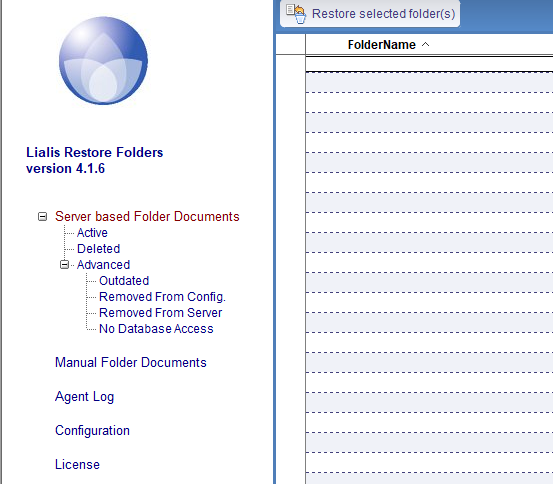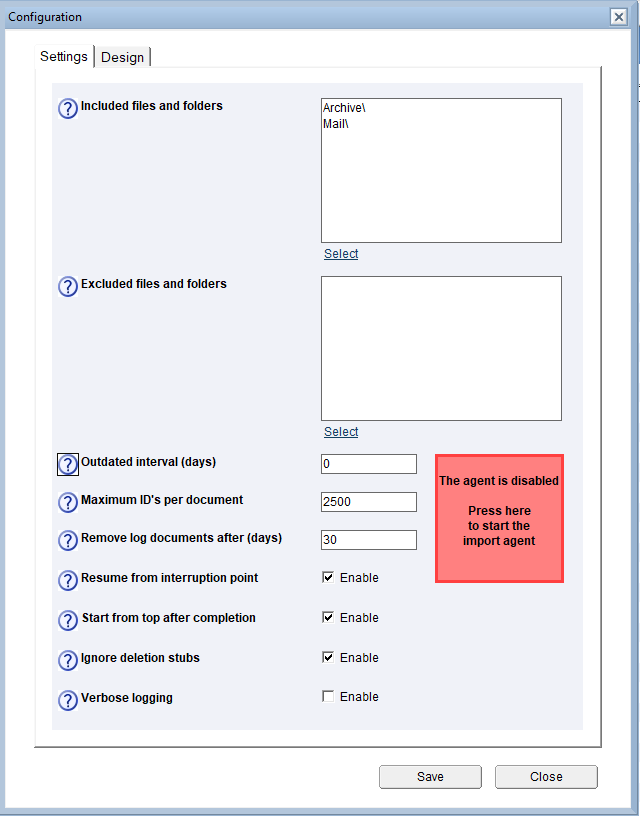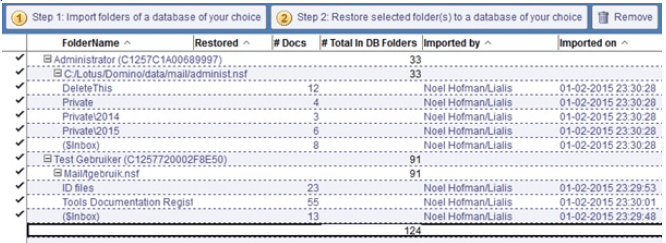Restore deleted Lotus Notes email folders
HCL Lotus Notes email restore folder activities are complex and time consuming. The Lialis Folder Restore Tool shortens and simplifies restoring deleted folders from HCL Notes mail files. Implement the Lialis Folder Restore Tool on your HCL Domino mail servers and the next time one of your Notes mail users deletes a folder by accident the Domino administrator is able to restore the deleted folder with a single mouse click.
Pricing
Please contact sales@lialis.com for purchase details.
Benefits
-
- Restore Notes mail deleted folders in HCL Notes email files by just clicking one button
-
- Identification of deleted HCL Notes email folders
-
- Emails are attached again automatically to the restored folders by this software
-
- Upload folders from a (local) Notes email file and restore folders to a (server based) mail file
-
- Full Lotus Notes solution, suitable for Domino R7, R8, R9, R10, R11 and R12
-
- Support for Domino server running on Windows and Linux OS
How to recover a deleted folder
A Notes folder contains a list of ‘pointers’ to the actual emails. When a user deletes a Notes mail folder, the folder with the pointers is removed from the Notes mail file, but the emails contained within the HCL Notes folder are not deleted from the mail file. The emails are still present in the Notes mail All Documents view.
The core of the Folder restore software is a scheduled Domino server based import agent that backs up the current state of all Notes folders in each Notes mail file and also checks for changes in the folder since the last run and records possible changes (like added or removed emails to this folder).
When a folder is deleted, this change is identified by the Folder Restore Tool application. See the image below as an example.
Simply select the deleted Notes mail folders to restore and press the button “Restore selected folders”. The folder is created in the mail file and all emails that belongs to this folder are added to the folder by our software.
Download software evaluation version
Folder Restore Tool Installation and Configuration
System requirements
HCL Domino 7 or higher. Domino server OS Windows and Linux.
Security
-
- The Lialis Restore Folder Solution creates a record of each mail folder name present in the Notes mail files. This information is only visible for users who have the Admin role of the Restore Folder database ACL.
-
- The Restore Folder Solution creates a record of each mail document in each folder by recording the email document ID. This ID is a number. Only this number is stored in the Restore Folder database, no other information like email subject, send from, send to, email body is stored in our software.
-
- End users may open the Restore Folder database when this access is allowed the database ACL In this case the user will only see his own personal folders. Notes Reader fields are used to limit access to regular users. Never assign the ACL Admin role to end users!
-
- No information of any sort is passed from the Restore Folder database to Lialis.
Installation instructions
-
- Extract the downloaded zipped package to any folder on your work station (not on the Domino server yet).
- Open the RFoldersR416.nsf database with your Notes client.
- Create a Notes database copy of RFoldersR416.nsf on the first Domino server where the mail files are on and change the file name into RFolders.nsf. If you have multiple Domino servers you must create database copies of RFolders.nsf on each Domino server. Replicating RFolders.nsf between Domino servers should not be done. Please start with one Domino server first. For clustered Domino servers you only need to run RFolders.nsf file on 1 of the Domino cluster mates that hosts all Notes mail files.
- Check the RFolders.nsf ACL, give Domino administrators and Domino servers groups manager access with the role Admin. You may choose to give end users access to this tool if you want the end users to be able to restore folders themself. But in most cases the restoring is done by Domino admins, so in this case don’t give access to end users to this software.
- Sign the Domino server based RFolders.nsf with a Notes ID that may run unrestricted Domino server agents on all Domino servers you are planning to implement this software. If you run this tool on 1 Domino server you may also choose to sign the tool with the Domino server ID.
-
- Open RFolders.nsf, you should see in the left navigator the options “Server based Folder emails”, “Manual Folder emails”, “Agent Log”, “Configuration” and “License”.
-
- Please press “License” and enter the license code you received by email from us. The server field value will be calculated by the software.
-
- Press the “Configuration” link and adjust the values on the Settings tab. Each question mark displays a pop-up with additional information when you click on it. For example:
-
- Select the mail directory/ies or files to be included.
- You may choose to exclude certain files or folders in the second setting.
- Set the outdated interval and the Maximum ID’s per document to 2500.
- Depending on the quantity of data that is to be processed, and the Notes Agent run-time settings, you may leave the settings “Resume from interruption point” and/or “Start from top after completion” enabled. Click the question mark for more information.
- Enable the setting Ignore deletion stubs.
- Verbose logging should only be enabled for troubleshooting purposes. If the tool is running fine, leave this check box unchecked. More information about these two settings can be found under the question mark hot spot.
- On the second tab “Design” of the configuration you may choose to add design elements to the mail file template in order to give the users the possibility to restore folders them self without interaction of Domino administrators. For now please leave this setting disabled by selecting “No” on the “Add Restore design elements to mail files setting”. More information on this setting can be found in this document more to the bottom.
- At the bottom of the configuration screen there will be a Red button with the text “The agent is disabled – Press here to start the import agent”. Please press this button to start the Import agent which will collect all folder details on the Domino server based on the configuration you have set in this database. The Import agent should start in a few seconds. You can change the agent run time of the Import agent by opening the RFolders.nsf database in the designer. The Domino server agent manager is now running the Import agent. If the maximum run time of the agent manager is not sufficient please increase the run time in the Domino server document, and/or enable the ‘Resume from interruption point’ and/or the ‘Start from top after completion’ checkboxes. The first import run will take more time than the second update run. Important, when you press this button the agent will be signed with your Notes ID. So you may need to resign the RFolders.nsf again with the signer ID file you have chosen previously.
- The view “Server based Folder emails – Active” displays the mail files and the folder details.
- If a user has deleted a folder, this deleted folder will show up in the view “Server based Folder emails – Deleted” after the Import agent run has finished. From both views (Active and Deleted) its possible to restore selected folders to the users mail file.
- The view “Server based Folder emails – Advanced” shows 4 advanced views.
-
-
- “Outdated” view. If a folder has been deleted from the mail database, you may specify the number of days to which this deleted folder should be available for restore in the configuration. If this interval is exceeded, the document will be moved to the ‘Outdated Folder emails’ view. For instance, if the Outdated interval is set to 30 days, a folder document with status ‘Deleted’ will remain available for restore for 30 days. On the 31st day, the document will be moved to the Outdated Folder emails view and will not be available for restore anymore. If, for some reason, somebody wants to restore a folder that has been set to Outdated, you can use the action ‘Move selected to ‘Deleted folders” in the Outdated Folder emails view, to make the folder available for restore again. There is also the option to set folder emails with status ‘Deleted’ to status ‘Outdated’ manually. You can do this by clicking the ‘Move selected to ‘Outdated folders’ button in the ‘Deleted Folder emails’ view.
- “Removed From Config.” view. This view displays the folders of mail files that are no longer configured to be included in the Folder Restore Tool configuration.
- “Removed From Server” view. This view displays the folders of mail files that are no longer stored on the Domino server.
- “No Database Access” view. This view displays the folders of mail files that are not accessible by the agent signer (Admin or server)
-
Folder Restore Tool solution Manual approach
The manual restore approach enables Notes administrators to restore folders from one Notes mail file to another Notes mail file. In fact, it is a copy action of folders with content. For this operation, the Administrator needs a backup copy of the users mail file where the deleted folders are still present. Although this is what the manually approach was designed for, with this approach it is also possible to copy folders from multiple databases on multiple locations to another Notes database at once. Whether the databases are located on a local disk or on a Domino server does not matter, as long as they can be accessed by the tool. From version 4.1.1 it is also possible to restore private (on first use) folders, as long as the user running the tool has access to these folders. In version 4.1.1, private source folders will be restored to the target database as standard shared folders, whereas in version 4.1.2, private source folders will be restored to the target database as private on first use folder. Note that you can only restore one private (on first use) folder at a time. This is because the folder needs to be opened at the front end, after the restore operation has finished. The option to restore to a private target folder only applies to the manual restore option. Source folders that are private, are marked with a red exclamation mark (!) in front of the view entry.
The manual restore approach does not need a license key, so its 100% free. The first step is to import folders and their document references into the Lialis Restore Folder application. By pressing the button “Step 1: Import folders of a database of your choice”, you can select a (local or server-based) Notes database and select the folders you want to import. You can repeat this step for each folder-containing database you want to include. When done the Administrator may select all or a subset of folders to be restored to a Notes (mail) file stored on a local drive or on a Domino server. In this example, folders from a local and a server-based mail file will be copied to another local database.
When the selection is made, press button “Step 2: Restore selected folder(s) to a database of your choice”. Choose the Notes database where you want to store these folders.
When the destination database is selected, an interface is displayed where you can configure how the folders are copied to the destination database.
The upper pane displays the folders that you are going to copy, and the location of the source database(s). Note that in this example, folders from multiple databases on multiple locations are copied to one destination database. The upper pane has a link that enables you to copy the whole folder tree, or just the main folders. When you click the link to exclude source folder tree from the restore, the source folder list will be updated immediately, as well as the Target DB preview (destination database) in the bottom pane. The middle pane shows all available folders in the destination database. Here you can select a folder to which you want to copy the folders and emails. When you select a folder, the Target DB preview will be updated immediately.
The – root folder – option will copy the folders in the IBM Lotus Notes email folder root of the destination database. You can also create a new folder(path) in the destination database where you can restore the folders. To do so, select the – new target folder – option and enter a folder(path) in the ‘New target folder’ field. Then press the [Refresh Preview] link to update the Target DB preview with this new folder. When you have configured it to your liking, press the ‘OK’ button to start the copy/restore process.
Because of the flexibility to copy IBM Lotus Notes email folders to any location, there is a chance that the restore process finds an existing folder with the same name in the destination database. Each time this happens, the user is prompted to overwrite this folder, or to add a folder with a postfix name “[originalfoldername]-RESTORED-n“. In this example, this will happen when the tool starts processing the second ($Inbox) folder.’
Please contact sales@lialis.com for purchase details.

